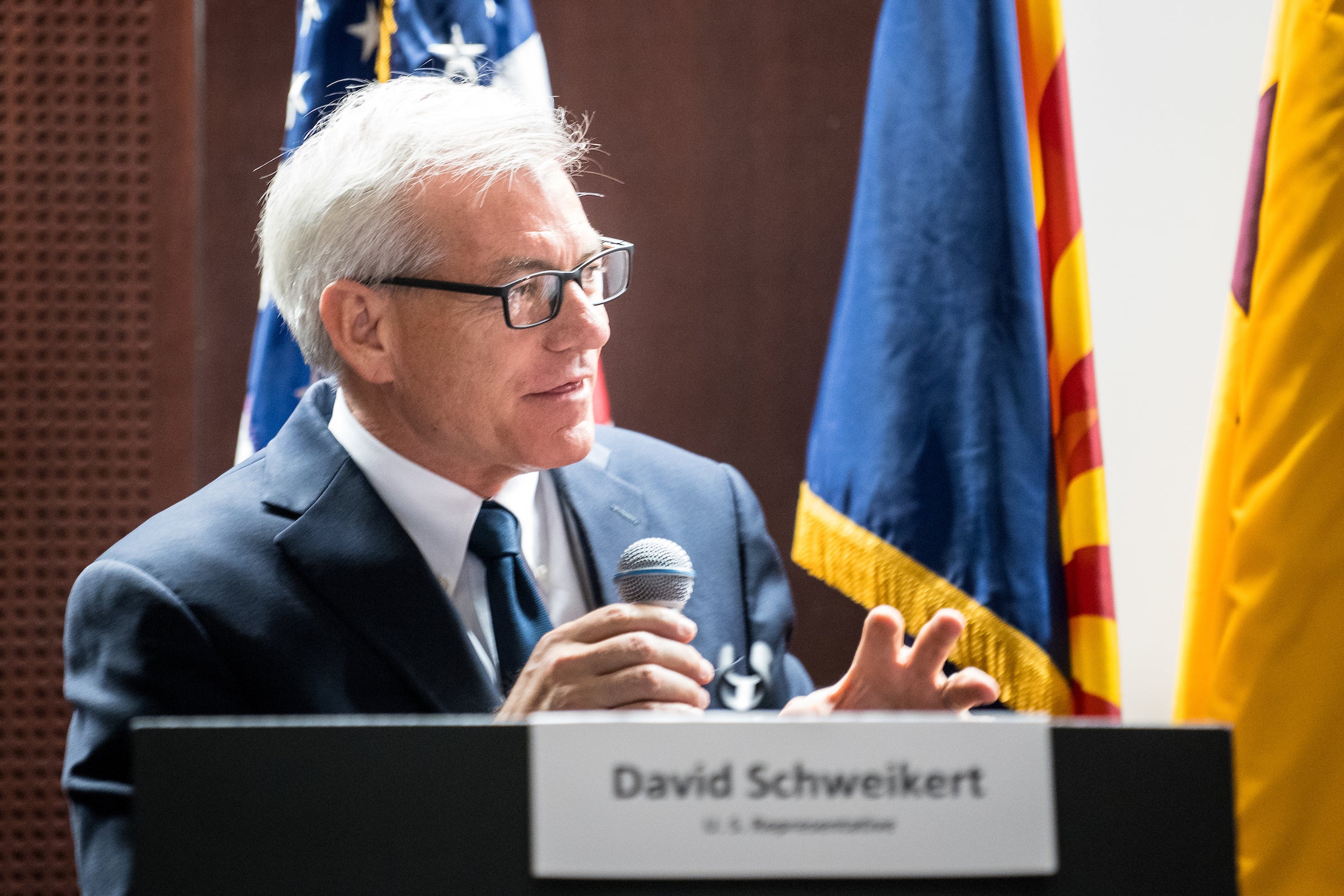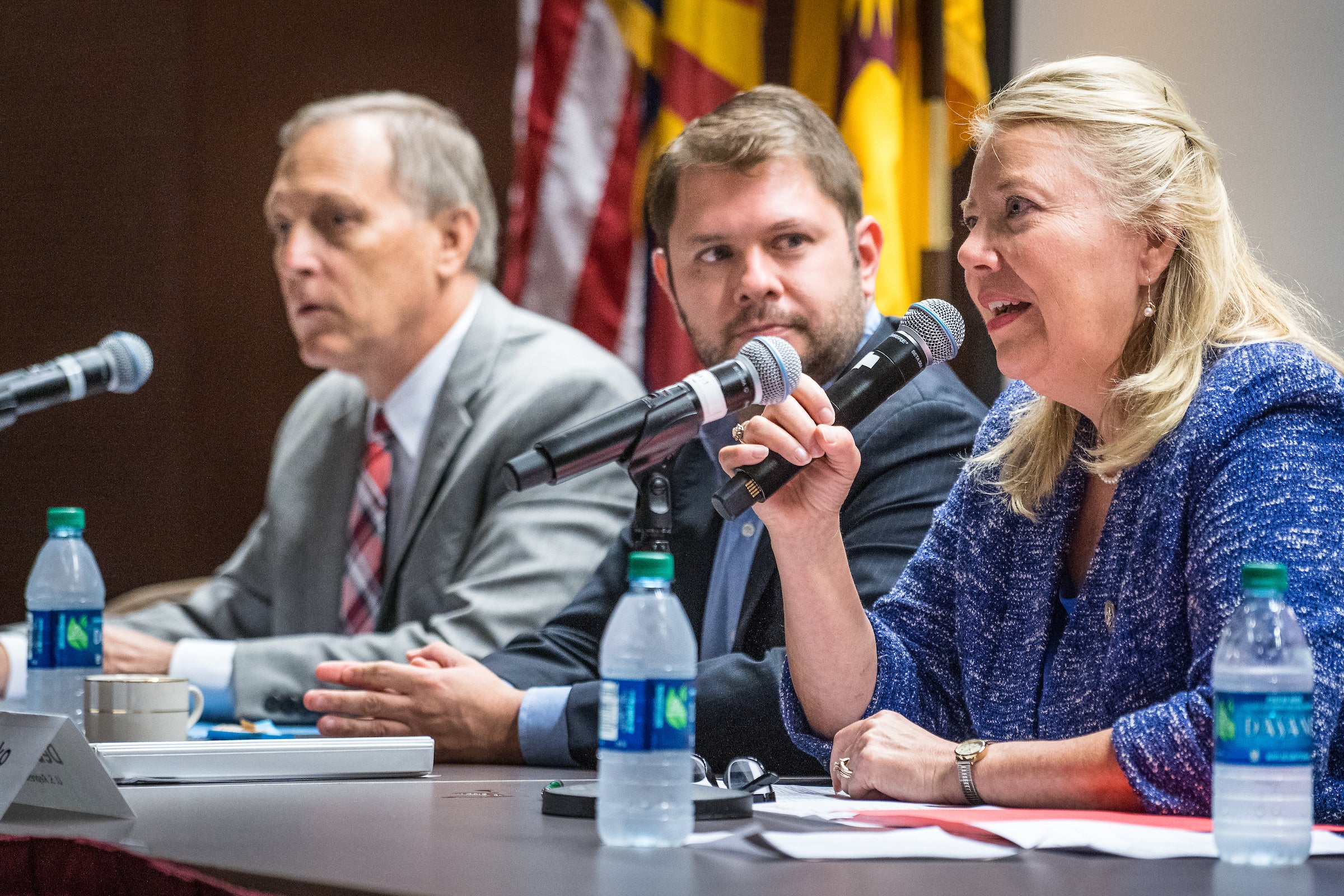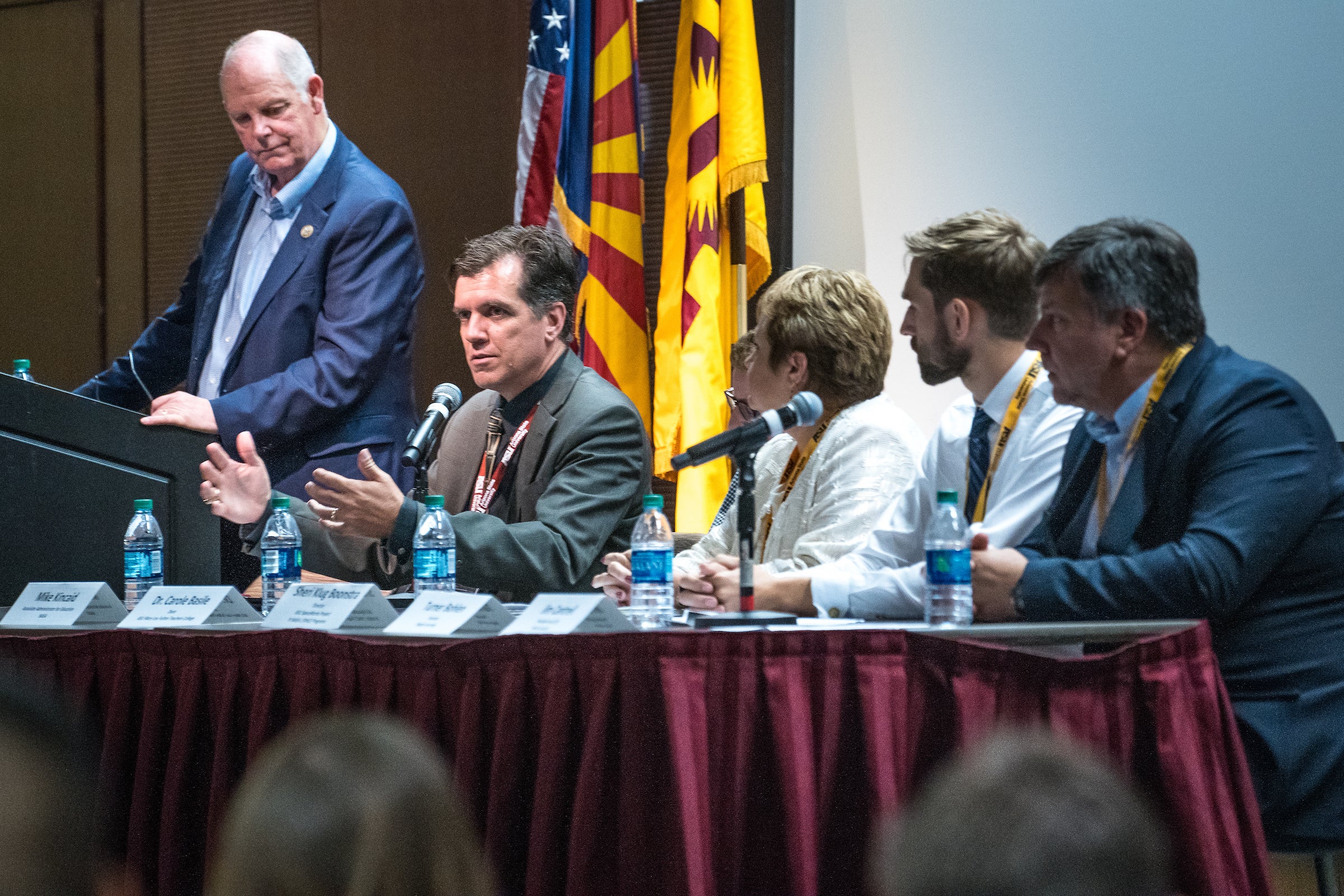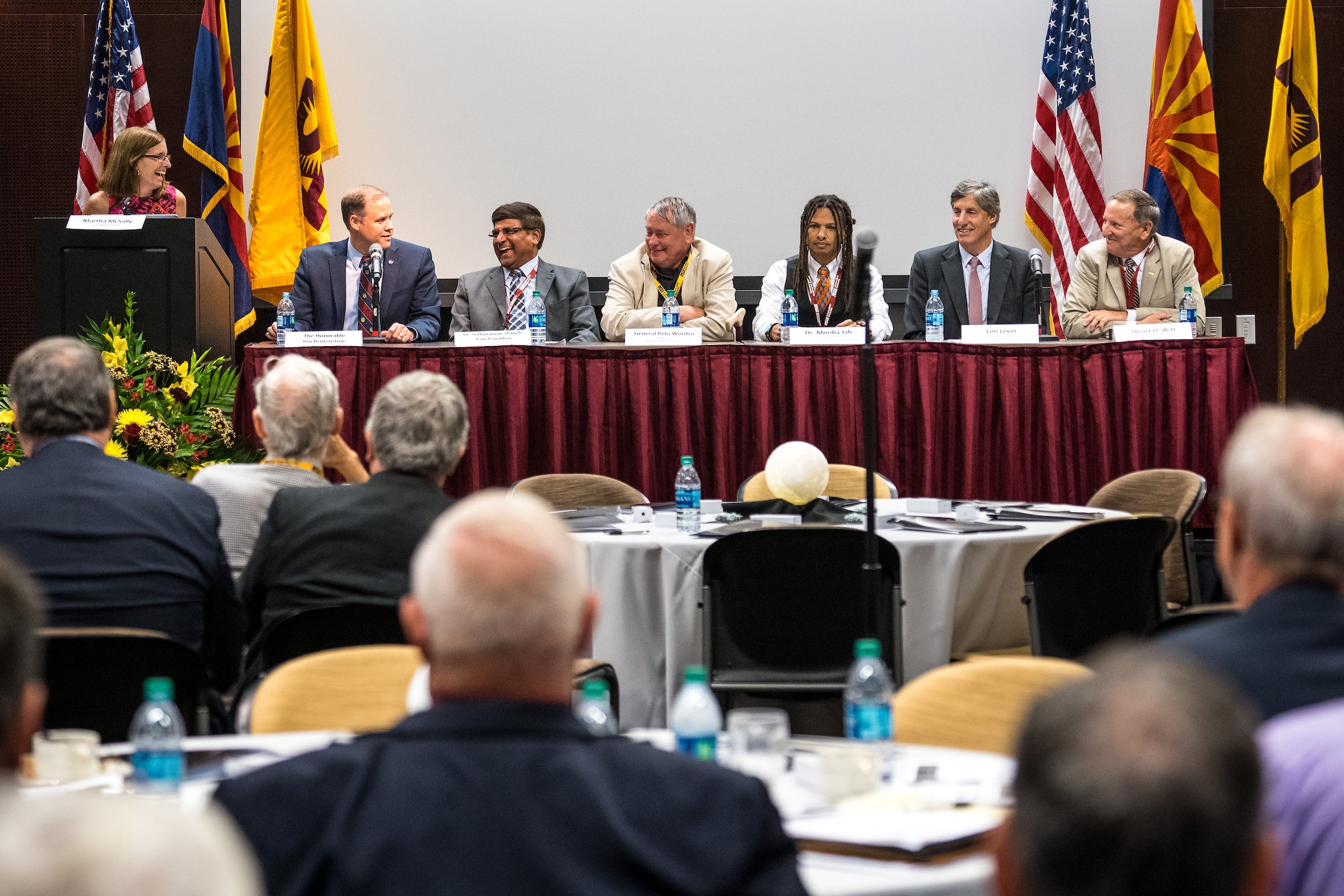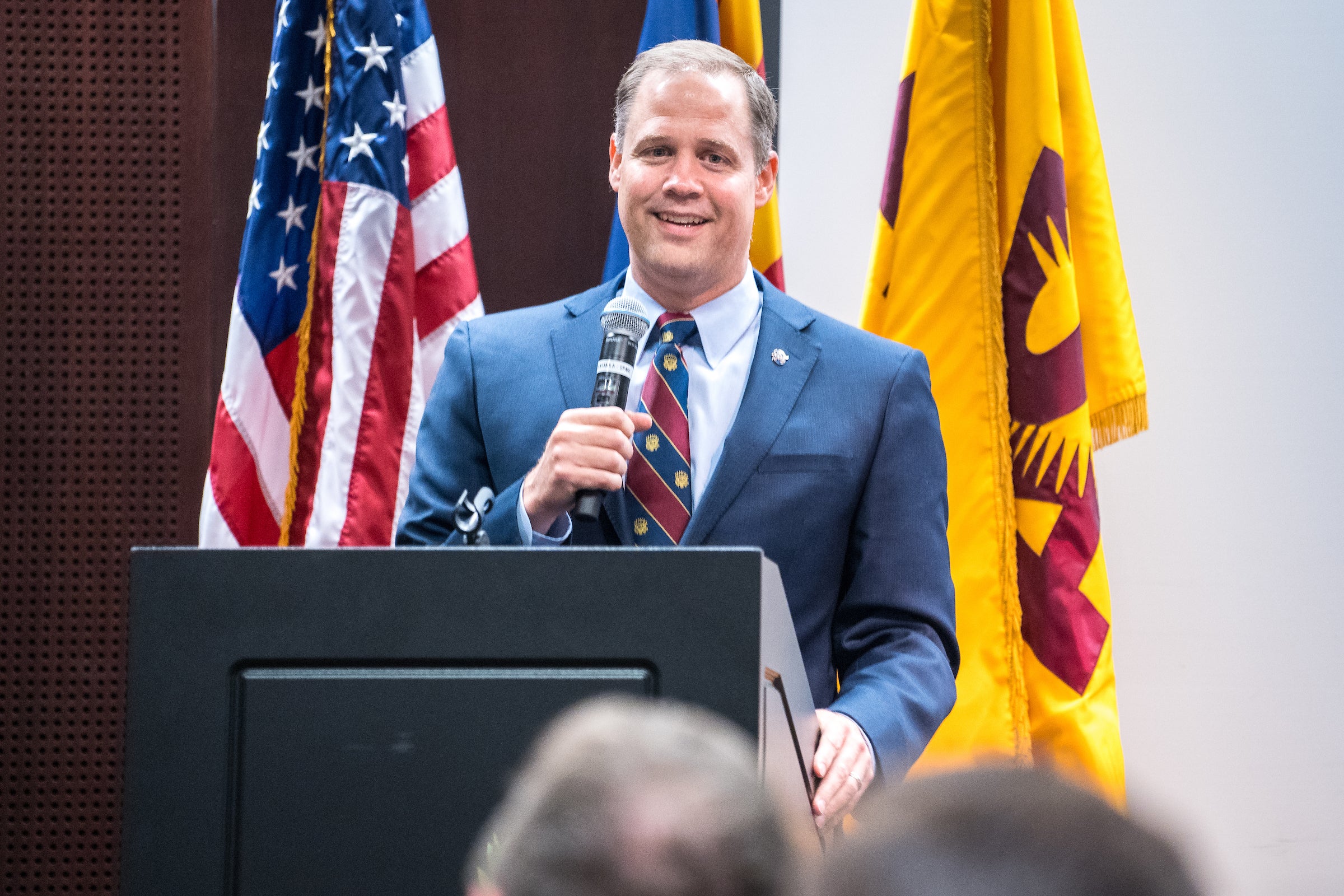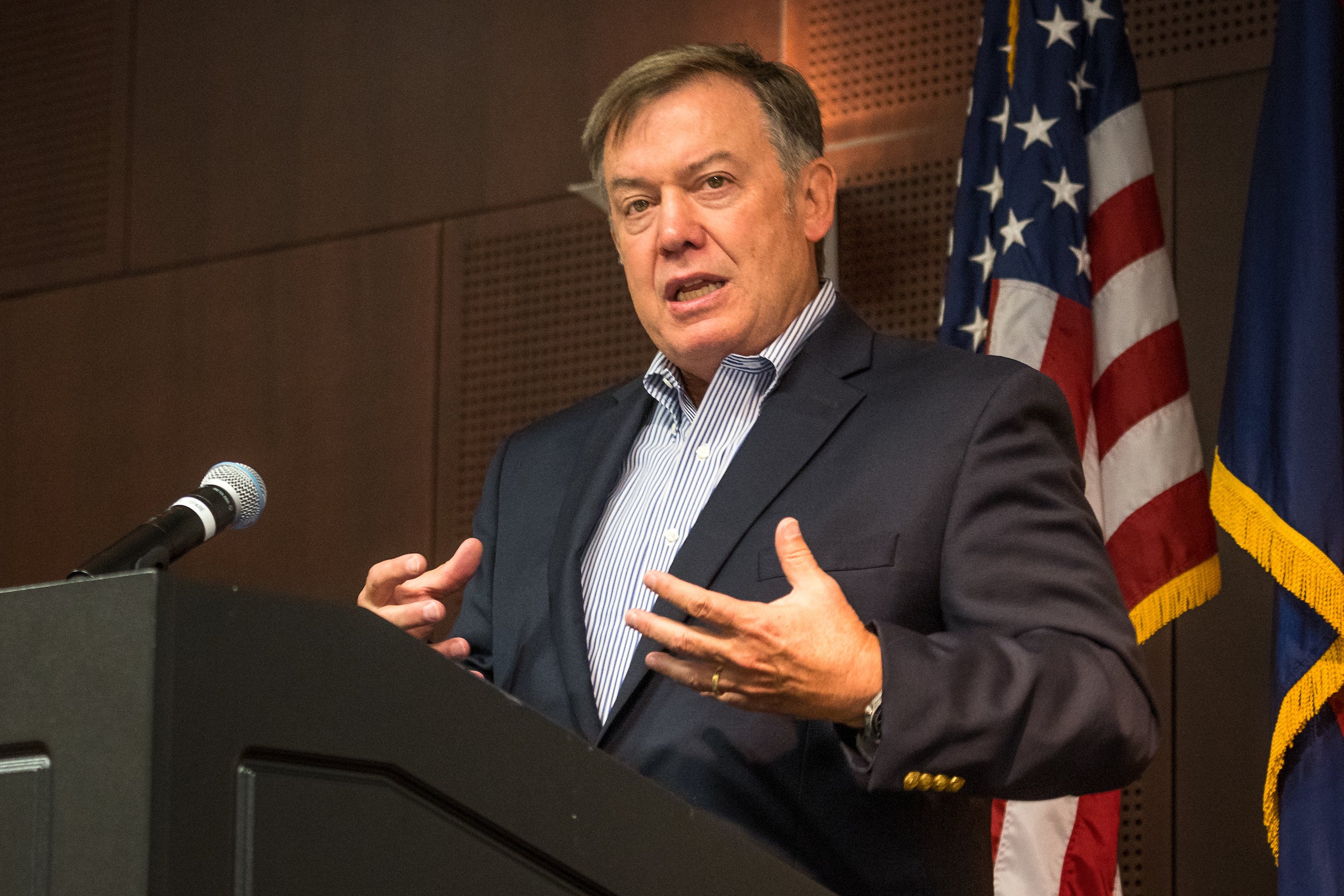ASU hosts Congress members, industry leaders for conference on space innovation

Arizona State University on Monday hosted the 2018 ASU Congressional Conference: Space Innovation at the Memorial Union on the Tempe campus. NASA officials, private space companies, scientists and academics attended the daylong event to discuss how to develop the workforce to get mankind into space, how the private and academic sectors can partner with government and what universities can contribute to space exploration.
ASU Now was there throughout the day; read on for recaps of the expert panel discussions.
What NewSpace companies have to offer
3:30 p.m.
The increasing role and visibility of smaller, often highly entrepreneurial commercial space companies with a higher tolerance for risk than traditional government space agencies or large aerospace companies — so-called “NewSpace” companies — has been a major factor in the recent revitalization of interest in space among both the general public as well as the investment capital communities. How best can leading academic institutions like ASU and others not only interact with but also forge new partnerships with these NewSpace players? The panelists for "NewSpace: Commercial – Academic – Government Partnerships" considered bridging divides in the space sector to advance the nation’s science, educational and economic goals, while at the same time advancing the goals of the academic and commercial sectors.
“Arizona is one of the top five states in terms of caring about space,” said Eric Stallmer, president of the Commercial Spaceflight Federation.
That's a break from the old model.
“It used to be that if you wanted to be in the space business you had to have a NASA center in your state,” said Erika Wagner, business development manager for Blue Origin. “That’s no longer true. … It’s more becoming about the passion and the investment than the location of the federal facilities.”
U.S. Rep David Schweikert was the moderator for the final panel of the afternoon on the business of space travel. Photo by Charlie Leight/ASU Now
ASU's entrepreneurial spirt leads the way
“More than any other university environment I ‘ve interacted with, we have an entrepeneurial spirit that is very consistent with being open to business,” said Jim Bell, ASU planetary scientist and a team member on a number of current and future NASA missions. “NASA trusts us because we have proven we can get the job done here in Arizona.”
“As long as we keep doing what we’re doing, Arizona will do just fine,” said NASA chief financial officer Jeff DeWitt.
The business of space travel
Wagner said the building blocks to create an amazing future are falling into place. She quoted her boss Jeff Bezos, who said that all the ingredients necessary to make Amazon a success were in place for him: interstate commerce, credit cards, the Internet. Private space outfits like Blue Origin and SpaceX are laying the groundwork.
Most of the panelists agree space tourism is going to change a lot of things. “People will decide they want to spend their money differently,” said Shawn Linam, founder of Qwaltec, a local space engineering firm.
“Business is the next big push,” DeWitt said. “In the middle of this big push to the private sector and the universities, we get to leverage our budget. Private industry allows us to go further faster.”
“In those realms where a business model can be pushed, business will go there,” Bell said. “There will always be a realm of pure exploration, though … That is going to remain in the realm of governments, probably forever.”
Space travel for all
Costs on satellites like cubesats and falling launch costs will bring more players into space.
“For less than the cost of new football uniforms, a U.S. high school can have its own space program,” Wagner said.
Qwaltec is helping ASU with the LunaH-Map mission to the moon.
Bell said space needs political stability and financial support from Congress to get deep into space. “I’m grateful for the support Congress has given us during the past decade,” he said.
The value of university partnership
2 p.m.
NASA has historically provided opportunities for leading universities and research institutions like those in Arizona to compete for opportunities for individual research scientists, individual flight instruments and even entire robotic space missions as part of its portfolio of the exploration of the solar system. Arizona’s universities and other research institutions have been extremely successful in these competitive opportunities, including bringing missions in on-time and on-budget, and reaping the scientific rewards on behalf of the nation and the world. What new opportunities can be created in missions, space instruments programs, technology development and student engagement that strengthen the role of the nation’s universities (including Arizona’s) in a way that advances NASA’s mission to explore our solar system, and beyond?
Following lunch, conference attendees saw an informal conversation with members of Congress on "NASA University-Competable Missions," featuring U.S. Rep. Andy Biggs, U.S. Rep Debbie Lesko and U.S. Rep Ruben Gallego.
(From left) Rep. Andy Biggs and Rep. Ruben Gallego listen to Rep. Debbie Lesko during an informal conversation about NASA University-Competable Missions at the 2018 ASU Congressional Conference: Space Innovation on Aug. 20, 2018. Photo by Charlie Leight/ASU Now
“This panel will largely be centered on success stories,” Biggs said as he introduced the panel, citing what NASA administrator Jim Bridenstine said earlier today: University-led NASA missions almost always come in on-time and under-budget. Simply put, NASA wants to do more of them.
ASU’s strategic strength lies in educating masses of students at scale. “MIT is a great school,” Gallego said. “But they don’t turn out the number of people we’re going to need (to go to space).” College education needs to be accessible and affordable, Gallego said. Pipeline development “will make (Arizona) a premier leader in this country.”
The budget for ASU’s Psyche mission and the UofA’s Osiris-Rex mission is $800 million combined, Biggs said. “And I think that’s money well spent, and we’re going to learn a lot from them.”
“I think it’s important to allow universities to compete with others if they can get projects done on-time and under-budget,” Lesko said. “If we can get more innovation and more competition with ASU, UofA, and even NAU, I think that’s great.”
Why universities have this capacity
Universities can fill the niche for small and mid-size missions, Biggs said. “If we’re serious about long-term space exploration, universities fill that mid-size niche in a very efficient way.”
“I think the institution has a reputation and prestige on the line," Biggs said. "The universities competing are an integral part of the space program.”
“I think small companies and universities are more nimble,” Gallego said.
Gallego closed by stressing the importance of mid-level workforce. Not everyone can or should be a rocket scientist; being a skilled machinist or manufacturing engineer is equally important. He urged investment in community colleges as well as K–12 and universities.
Preparing a space workforce
12:15 p.m.
As the National Science Board reiterated this year, our nation’s future competitiveness relies on building a STEM-capable U.S. workforce. And this need is even more compelling in the burgeoning space economy. With 56 percent of its workforce at 50 years old or older and with nearly 21 percent retirement eligible, NASA is in critical need of a new approach to building a workforce pipeline. Our educational system is not keeping up with demand — we need to teach and learn in newer, more innovative ways. The "Education and the Future Workforce for Space" panelists covered how universities, the government and the private sector can create a more seamless transition to the workforce.
“As a country, we’ve always had a sense of exploration,” panel moderator U.S. Congressman Tom O’Halleran said. “I think NASA incorporates that into its process, and it needs to be supported.”
Training collaborative problem solvers is more important than STEM education, said Turner Bohlen, founder of Beagle Learning, Inc.
Sheri Klug Boonstra of ASU Spaceworks Project and the NASA L'SPACE Academy, a veteran of NASA educational efforts, agreed: “We have to reimagine what education looks like, from K–12 to workforce."
From left, Rep. Tom O'Halleran moderates a panel discussion on Education and the Future Workforce for Space with Mike Kincaid, Carol Basile, Sheri Klug Boonstra, Turner Bohlen and Jim Cantrell. Photo by Charlie Leight/ASU Now
What does NASA need to build its future workforce?
“In a sense we need nothing because we have thousands of people applying for every job,” said Mike Kincaid, NASA associate administrator for education.
But are those applicants prepared for the immediate needs of the industry?
“How do we actually give students more experience before they graduate?” Klug Boonstra said. “We’re giving them that backstage pass to how things really work at NASA. We want to give students opportunities before they get to the door of their first hire.”
Bohlen pointed out that collaborating and working as a team are crucial skills.
“If you put a real project that a company is working on in front of a student, you’re going to get engagement and an actual productive result from the classroom,” he said.
Cross-disciplinary emphasis
Jim Cantrell, president and CEO of Vector Launch, said the consumerization of space is coming, where in five years you can launch your own satellite and program it with an app. Space transportation is going to open up space the way elevators opened up Manhattan.
The ability to move across disciplines is important in a fluid environment where someone might move from field to field in the course of a career, Klug Boonstra said. “We have to start early,” she said, at the kindergarten level. “NASA can be a big part of that.”
“We cannot be thinking of the 21st and 22nd centuries and educating with a 20th-century model,” said Carol Basile, dean of the Mary Lou Fulton Teachers College.
Setting the stage for expanded space industry
10:30 a.m.
What are the major present-day challenges facing NASA in 2018? The "Scoping the Problem – NASA Challenges in 2018" panel discussed how to prioritize efforts to address education and workforce development, mission costs and effectiveness, new missions and new/commercial space development and partnerships.
NASA’s budget is healthy, NASA Administrator Jim Bridenstine said, increasing this year from $19 to $20 billion.
“That hasn’t happened in my lifetime,” he said. He added that exploration and discovery is the organization's main focus.
"We don't want to be the second country to discover life on another planet," Bridenstine said.
From left, Rep. Martha McSally, Jim Bridenstine, Sethuraman "Panch" Panchanathan, retired General Pete Worden, Moriba Jah, Lon Levin, and Stuart O. Witt, on "Scoping the Problem – NASA Challenges" at the 2018 ASU Congressional Conference: Space Innovation conference. Photo by Charlie Leight/ASU now
Cost efficiency
Reusable rockets and shuttles will transform space exploration, Bridenstine said several times. “It will democratize space,” he said, drastically reducing costs by having rockets which can be used up to 20 or 30 times.
“We can mitigate cost by doing more missions at a lower cost,” he said.
Getting students involved
Given the proper equipment and facilities like vacuum chambers and clean rooms, more research can be conducted at universities at the NASA level, said Moriba Jah, associate professor of aerospace engineering and engineering mechanics at the University of Texas, Austin.
“Let’s put students there,” Stuart O. Witt, former CEO, Mojave Air and Space Port, Chairman Emeritus, National Space Council Users Advisory Group, said of the International Space Station. “I think we need to get younger people there, and to get them there in greater numbers during this transition.”
Industry needs to incentivize students to solve problems, Jah said. Industry acts like someone who keeps going to a store to buy fish instead of investing in a hatchery, he said.
“The thing universities bring to the table is the art of the possible,” he said.
NASA’s workforce is aging
“NASA gets better one funeral at a time,” said retired General Pete Worden, chairman of the Breakthrough Foundation, National Space Council Users Advisory Group, causing a bit of a stir in the room. “Don’t assume you take a job and stay there 50 years.”
NASA is a popular place to work, people love working there, and they don’t like to leave. The average NASA worker is over 50.
“The point he made is relevant,” Bridenstine said. “Our turnover is four percent annually. They never leave.
“Universities like this are going to have to help us resolve this over the coming decades.”
The panel also included moderator U.S. Representative Martha McSally; Sethuraman "Panch" Panchanathan, executive vice president ASU Knowledge Enterprise; and Lon Levin, president and CEO of GEOShare.
Building on technologies to get to Mars
9:30 a.m.
Former Congressman and NASA Administrator Jim Bridenstine delivered the keynote address to the conference.
“One of my jobs is to make sure Americans realize how important space is in their lives. … A lot of people don’t realize it," he said. "A lot of people in this room probably get broadband. … We do it with space-based architectures.”
Technologies that affect farming, communication, materials, industry, and many other fields are space-based. “These are capabilities that are based on our investment in space,” Bridenstine said.
NASA Administrator Jim Bridenstine
NASA builds the satellites which produce the data the evening weather forecast is based on. Banking requires GPS timing signals.
“If we lose timing signals, there’s no milk in the grocery store in three days,” he said. “A lot of people don’t realize how important space is in our daily lives.”
Bridenstine talked about the LunaH-Map mission being built at ASU.
“That’s really important to NASA,” he said, citing how important it will be to map the billions of tons of ice on the moon necessary to provide the push to Mars and beyond.
Bridenstine talked about a future where a gateway space station permanently orbits the moon and private and international missions dock there, where lunar landers shuttle between the surface of the moon and back again.
“What this gains us is more access to more parts of the moon,” he said, describing how ice can be used for fuel and drinking water. “The U.S. ought to be first in making those discoveries. … We want to utlilize the resources of the moon. That’s never been our priority. It is now.”
The moon is the best place to minimize the risks of going to Mars, he said. “We want all these technologies to be produced with an eye towards going to Mars.”
Generating thought leaders of tomorrow
8:30 a.m.
ASU President Michael Crow opened the conference by describing the challenges involved in making the great leap to space, and how ASU engineering is contributing by flooding engineers into the field.
“Heavy research, heavy innovation, and thousands and thousands of people who had no access to the culture in the past,” Crow said. “How to think differently; that’s what this meeting is about.”
President Michael Crow delivers his welcoming comments at the 2018 ASU Congressional Conference: Space Innovation, on Aug. 20. Photo by Charlie Leight/ASU Now
Crow was followed by Sethuraman “Panch” Panchanathan, executive vice president, ASU Knowledge Enterprise who gave a conference overview:
“Now we are moving from global problems to interplanetary problems. That’s what the School of Earth and Space Exploration is about,” he said. “We are here to do the job of generating thought leaders.”
Panchanathan said the generation that will take us off-planet needs to be educated. How will that be accomplished? How can private industry and academia work best with NASA to accomplish that mission?
“What is the vision for the future? That is what we are going to be talking about (today).”
Top photo: Blue Origin's Erika Wagner, second from right, speaks during the panel discussion on NewSpace: Commercial – Academic – Government Partnerships at the 2018 ASU Congressional Conference: Space Innovation, on Aug. 20, 2018. More than 150 people attended the daylong conference. Photo by Charlie Leight/ASU Now
More Science and technology

ASU postdoctoral researcher leads initiative to support graduate student mental health
Olivia Davis had firsthand experience with anxiety and OCD before she entered grad school. Then, during the pandemic and as a result of the growing pressures of the graduate school environment, she…

ASU graduate student researching interplay between family dynamics, ADHD
The symptoms of attention deficit hyperactivity disorder (ADHD) — which include daydreaming, making careless mistakes or taking risks, having a hard time resisting temptation, difficulty getting…

Will this antibiotic work? ASU scientists develop rapid bacterial tests
Bacteria multiply at an astonishing rate, sometimes doubling in number in under four minutes. Imagine a doctor faced with a patient showing severe signs of infection. As they sift through test…
